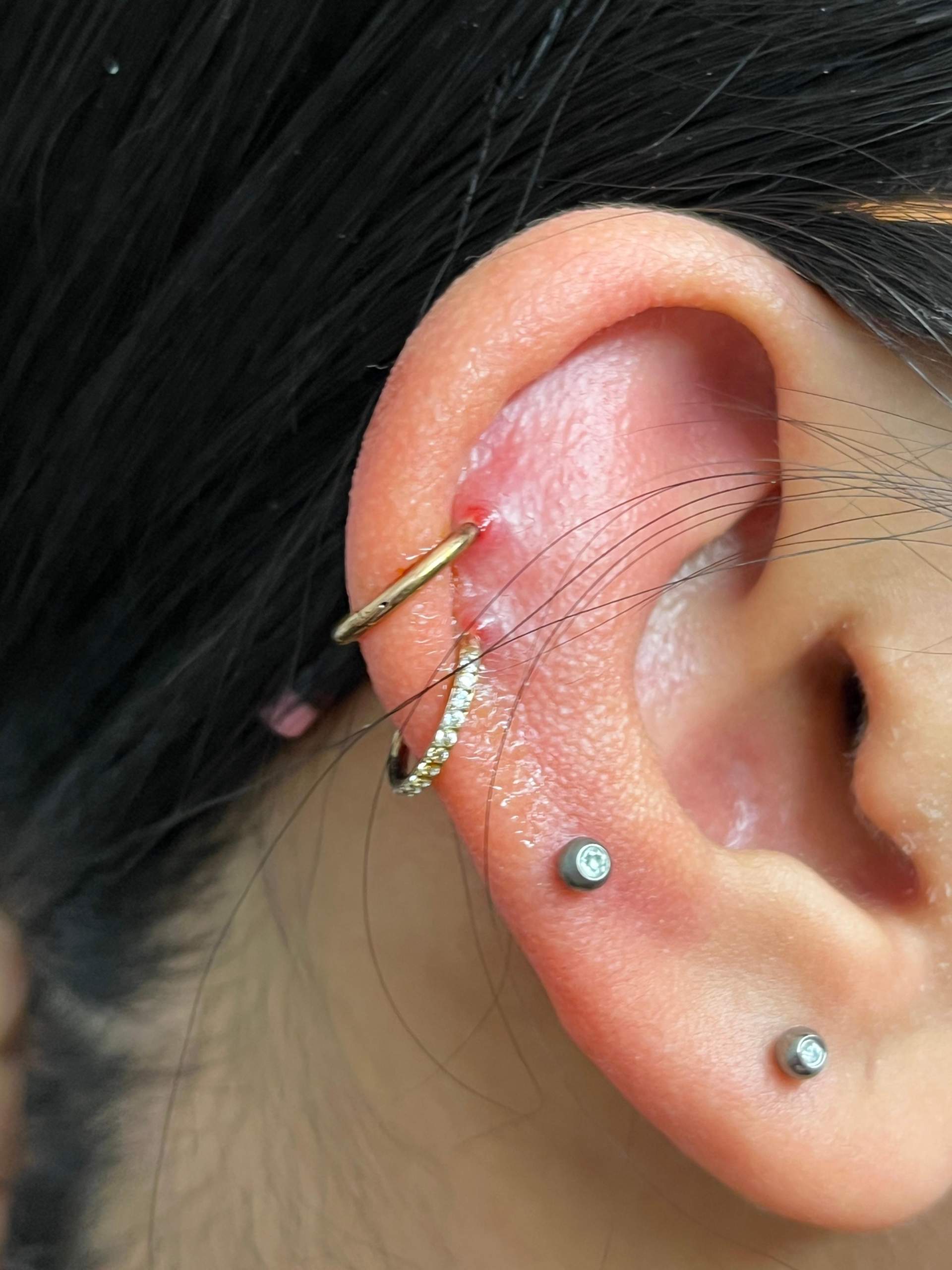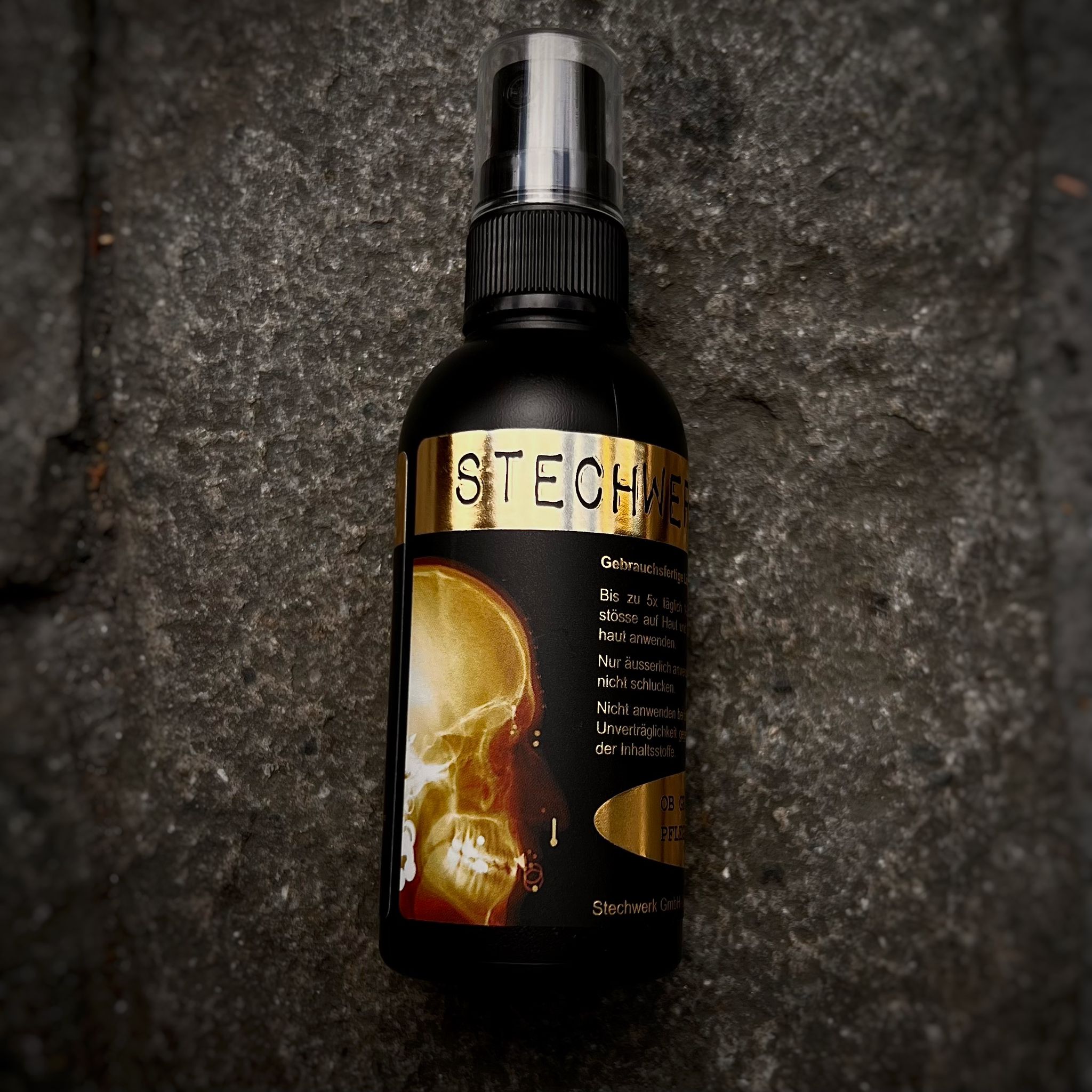Approximate healing times:
- Ear piercings (lobes): 4-6 weeks
- Ear cartilage such as helix, tragus, conch, flat: 3-6 months
- Ear cartilage such as Daith, Rook, Industrial: 4-12 months
- Nostril (nose sideways): 3-6 months
- Tongue (normal) & Snakeeye: 4-8 weeks
- Tongue & lip ligament: 2-3 weeks
- Lips like Labret, Ashley, Eskimo (Vertical-Labret),
- Madonna, Monroe, Medusa: 4-8 weeks
- Bridge, eyebrow, septum, venom bites: 2-3 months
- Nipple 1.2mm, dermal anchor: 2-3 months
- Nipple 1.6mm, navel, surface: 4-6 months
- Cheeks, Dahlias: 4-12 months
- Christina, Pubic: 4-6 months
- KVV, KVH, Labia (Minora & Majora): 4-8 weeks
- Frenum, Hafada, Prince Albert: 4-8 weeks
- Ampalang, Apadravya, Reverse PA, Guiche: 3-6 months
- Fourchette, triangle, Princess Albertina: 2-3 Monate
Mouth & oral piercings:
- 3 times a day, the recommended mouthwash (Easy Piercing) or mouth spray (Prontolind Mouth Spray) according to the description on the bottle.
- For the first 2 weeks, rinse with a mild mouthwash (e.g. camomile tea) after every meal/drink.
- Avoid animal dairy products, fruit or fruit juices, too hot, spicy or acidic food/drinks for 2 weeks.
- For swelling, suck on ice cubes made from chamomile or sage tea.
- No wet kissing or oral sex during the healing phase.
Intimate piercings:
- No sexual intercourse for at least 4 weeks, no oral sex.
- Until complete healing, only protected intercourse (condoms).
Micro dermal anchor:
- The Micro Dermal Anchor for at least 2 weeks Cover with a plaster. Change the plaster twice a day and care instructions repeat the care instructions.
Step 1: Wash your hands and spray the piercing with a suitable piercing care spray, such as our Piercing Care.
Please never touch the piercing with unwashed hands.
Step 2: Carefully remove crusts as lymph fluid and blood with a clean handkerchief.
The best way to do this is to soften the crusts. Please do not use Q-tips, do not scratch.
Step 3: Spray the piercing again with our piercing care.
Repeat these 3 steps 3-5 times a day until the piercing is completely healed.

The piercing should only be performed if necessary with thoroughly washed and disinfected hands washed and disinfected hands.

Disinfect the piercing at least 3-5 times a day with a suitable piercing care spray such as our Piercing Care. From Octenisept, Merfen or similar sprays as these were designed for cuts and burns and not for piercings, which need to be disinfected for much longer. which need to be disinfected for much longer.

Do NOT use Q-tips (cotton buds) to Cleaning the piercing. Q-tips can cause irritation and inflammation in piercings. We recommend using a standard handkerchief or swab to clean the piercing.

A piercing can always become infected! This is no reason to panic. It is often sufficient to disinfect the piercing several times. If this does not help, please come and show us the piercing.

Avoid at least until half of the healing time Bathing or swimming (also sea, lake, bathtub), sauna, solarium & sunbathing.

The piercing should never be changed before it has completely healed. The healing time of a piercing varies from person to person.
Tips & tricks for piercing care
The piercing should not be changed or removed until it has completely healed. Changing it too early can lead to serious problems. We advise against independent removal.
Creams such as body lotion, face cream, make-up or similar must not come into contact with the piercing. Creams and make-up can lead to irritation and inflammation/infection. We generally advise against the use of creams.
We recommend care / disinfection exclusively with a suitable piercing care spray such as our Piercing Care. With our piercing care spray we have had the best experience over the years.
For mouth & oral piercings we recommend the use of a
suitable mouthwash (Easy Piercing) or mouth spray (Prontolind mouth spray).
Piercings can become crooked or cause problems if you sleep on them or if constant pressure is applied. Such as by wearing too tight clothing, headphones or motorcycle helmets. Caution is always advised.
Bleeding, swelling and bruising can occur with any piercing. This is nothing to worry about. Cover any bleeding with a clean handkerchief and press firmly until the bleeding stops. Alcohol in the blood inhibits the blood platelets from closing wounds, so longer bleeding is to be expected.
Avoid the following until about halfway through the healing time
Swimming or bathing (also sea, lake, bathtub), sauna and solarium as well as sunbathing. Tight clothing / lace underwear can also be irritating.
Game meat

Wildlfeisch, hypertrophic scar, lump...?
Wild meat is a collective term for excess scar tissue from piercings. In this collective term you will find different types of terms such as: Bulge scar, Keloid, Hypertrophic scar, Granulated tissue, Hypertrophic granulation etc. As it is often very difficult to distinguish between these and there can also be fluid transitions between them, the collective term “wild flesh” is usually used.
Wild meat describes an excessive growth of granulation tissue during the healing phase of a piercing. It appears as a reddish, soft and usually painless nodule that grows beyond the edges of the wound.
The development of game meat can have various causes:
- Inflammation: Infections, mechanical irritation caused by too tight jewelry or improper care can lead to inflammation, which in turn promotes the formation of venison.
- Movement and tension: Too much movement and tension can impair the healing of the wound, which can lead to gamey meat.
- Genetic predisposition: Some people have a stronger genetic tendency to form scars and gamey meat.
Treatment options:
The treatment of wild flesh and hypertrophic scars on piercings requires patience and consistency. The earlier the treatment begins, the better the chances of success.
Possibilities for the treatment of game meat:
- Jewelry change: Often, to properly treat game meat, a jewelry change is a first step in a direction of improvement.
- Hydrogen peroxide 3%: Hydrogen peroxide is a powerful disinfectant that dries out the excess scar tissue on game meat so that it can break down. You should apply hydrogen peroxide to the affected area 6-8 times a day for it to have an effect.
- No-Pull Disc: No-pull discs are silicone plates that are placed on the piercing bar to exert pressure on the venison so that it can break down. You should use one disc per venison scar.
- Surgical removal or treatment: In rare cases, surgical removal of the venison may be necessary. Or a dermatologist can treat the venison with cortisone.
Prevention:
Careful care of the wound is particularly important to prevent the formation of wild meat on piercings.
The following tips can help:
- Hygiene: The piercing should always be kept clean and should only be touched with disinfected or washed hands.
- Disinfection: The piercing should be regularly disinfected with a piercing disinfectant, such as our Piercing Care.
- Jewelry: The jewelry should be made of surgical steel, titanium or real gold and adapted to the piercing site.
- Avoidance of irritation: The piercing should not be touched. Avoid scratching or getting caught, as well as moving the jewelry too much.
Discover our care products
Visit our online store and discover our high-quality piercing care products that have been specially developed to support healing and prevent infections. If you have any questions or need professional advice, don’t hesitate to contact us. Our experienced team is always available to provide you with help and advice.

